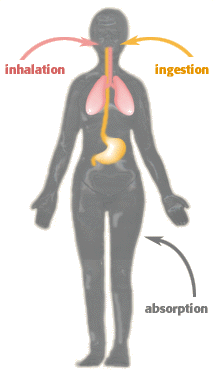
Toxicology Problem Set
Problem 3: Routes of entry
For help to answer the question:
Which of the following is NOT a possible route of entry for a hazard?
A. ingestion B. absorption C. exposure D. inhalation
Tutorial
To cause harm to a person, a hazard must enter the body. Merely being exposed will not cause harm if the hazard does not actually enter the body. There are three primary ways that a hazard can enter the body:
Ingestion - Chemicals that are ingested enter the body by being eaten. From the digestive track, they can go to the liver or the lymphatic system and then on to the bloodstream. Some chemicals are not absorbed by the digestive track, so they pass through the body and are excreted in the feces.For example, a pack of cigarettes in a man's shirt pocket does not cause harm to him because nothing from the cigarettes has entered his body. If, however, he smokes one of the cigarettes, the smoke has entered his body through his lungs and can cause harm.
|
The Biology Project
The University of Arizona
Tuesday, September 16, 1997
Contact the Development Team
http://www.biology.arizona.edu
All contents copyright © 1997. All rights reserved.
 Inhalation - Chemicals can be breathed into the lungs, called inhalation. The inside surface of the lungs very large and is a poor chemical barrier. Many chemicals that are inhaled can easily and quickly enter the bloodstream from the lung tissue.
Inhalation - Chemicals can be breathed into the lungs, called inhalation. The inside surface of the lungs very large and is a poor chemical barrier. Many chemicals that are inhaled can easily and quickly enter the bloodstream from the lung tissue.





